Related Research Articles

St. Augustine is a city in and the county seat of St. Johns County located 40 miles south of downtown Jacksonville. The city is on the Atlantic coast of northeastern Florida. Founded in 1565 by Spanish explorers, it is the oldest continuously inhabited European-established settlement in what is now the contiguous United States.

Appletons' Cyclopædia of American Biography is a six-volume collection of biographies of notable people involved in the history of the New World. Published between 1887 and 1889, its unsigned articles were widely accepted as authoritative for several decades. Later the encyclopedia became notorious for including dozens of biographies of people who had never existed. In nearly all articles about the Cyclopædia various authors have erroneously spelled the title as 'Appleton's Cyclopædia of American Biography', placing the apostrophe in the wrong place.

Jean Ribault was a French naval officer, navigator, and a colonizer of what would become the southeastern United States. He was a major figure in the French attempts to colonize Florida. A Huguenot and officer under Admiral Gaspard de Coligny, Ribault led an expedition to the New World in 1562 that founded the outpost of Charlesfort on Parris Island in present-day South Carolina. Two years later, he took over command of the French colony of Fort Caroline in what is now Jacksonville, Florida. He and many of his followers died at the hands of Spanish soldiers during the Massacre at Matanzas Inlet, near St. Augustine.

Pedro Menéndez de Avilés was a Spanish admiral, explorer and conquistador from Avilés, in Asturias, Spain. He is notable for planning the first regular trans-oceanic convoys, which became known as the Spanish treasure fleet, and for founding St. Augustine, Florida, in 1565. This was the first successful European settlement in La Florida and the most significant city in the region for nearly three centuries.
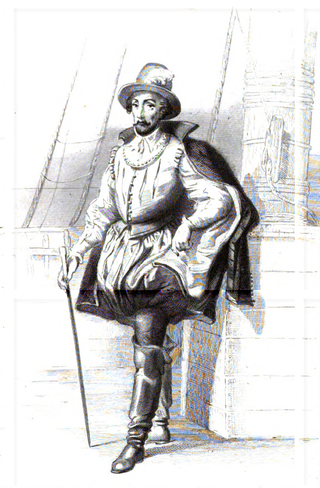
Rene Goulaine de Laudonnière was a French Huguenot explorer and the founder of the French colony of Fort Caroline in what is now Jacksonville, Florida. Admiral Gaspard de Coligny, a Huguenot, sent Jean Ribault and Laudonnière to explore potential sites in Florida suitable for settlement by the French Protestants.

Spanish Florida was the first major European land-claim and attempted settlement-area in northern America during the European Age of Discovery. La Florida formed part of the Captaincy General of Cuba, the Viceroyalty of New Spain, and the Spanish Empire during Spanish colonization of the Americas. While its boundaries were never clearly or formally defined, the territory was initially much larger than the present-day state of Florida, extending over much of what is now the southeastern United States, including all of present-day Florida plus portions of Georgia, South Carolina, North Carolina, Alabama, Mississippi, and the Florida Parishes of Louisiana. Spain based its claim to this vast area on several wide-ranging expeditions mounted during the 16th century. A number of missions, settlements, and small forts existed in the 16th and to a lesser extent in the 17th century; they were eventually abandoned due to pressure from the expanding English and French colonial settlements, the collapse of the native populations, and the general difficulty in becoming agriculturally or economically self-sufficient. By the 18th century, Spain's control over La Florida did not extend much beyond a handful of forts near St. Augustine, St. Marks, and Pensacola, all within the boundaries of present-day Florida.
The Jaega were Native Americans living in a chiefdom of the same name, which included the coastal parts of present-day Martin County and northern Palm Beach County, Florida at the time of initial European contact, and until the 18th century. The name Jobé, or Jové, has been identified as a synonym of Jaega, a sub-group of the Jaega, or a town of the Jaega.
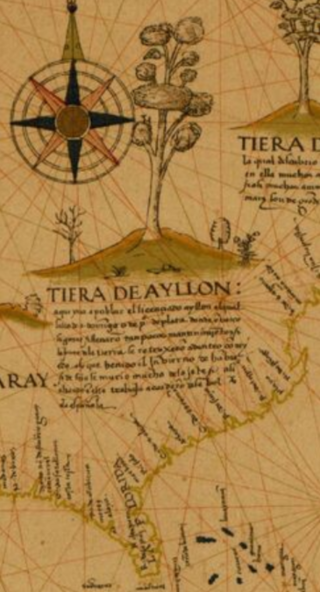
San Miguel de Gualdape was a short-lived Spanish colony founded in 1526 by Lucas Vázquez de Ayllón. It was established somewhere on the coast of present-day Carolinas or Georgia, but the exact location has been the subject of a long-running scholarly dispute. It was the first European settlement in what became the continental United States, and the third in North America north of Mexico.
Martín de Argüelles Jr. (1566–1630) was the first white child known to have been born in what is now the United States. His birthplace of St. Augustine, Florida is the oldest continuously occupied, European-founded city in the United States.

The Ajacán Mission was a Spanish attempt in 1570 to establish a Jesuit mission in the vicinity of the Virginia Peninsula to bring Christianity to the Virginia Native Americans. The effort to found St. Mary's Mission predated the founding of the English settlement at Jamestown, Virginia, by about 36 years. In February 1571, the entire party was massacred by Indians, except for Alonso de Olmos. The following year, a Spanish party from Florida went to the area, rescued Alonso, and killed several Indians.

Ajacán – variants include Xacan, Jacan, Iacan, Axaca and Axacam – was a short-lived Spanish settlement, between 1570 and 1571, near Chesapeake Bay, in what would later become Virginia.
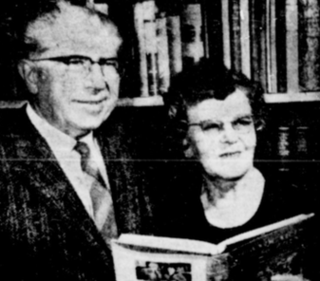
LeRoy Reuben Hafen was a historian of the American West and a Latter-day Saint. For many years he was a professor of history at Brigham Young University (BYU).
Hernando de Manrique de Rojas was a Spanish colonial governor of the Colony of Santiago (Jamaica) c.1575.
Sebastián Montero was a Spanish secular priest who was active in the later half of the sixteenth century in North America. In the historical record, Montero was the first person to introduce Christianity in what is now North Carolina.

The Spanish assault on French Florida began as part of imperial Spain's geopolitical strategy of developing colonies in the New World to protect its claimed territories against incursions by other European powers. From the early 16th century, the French had historic claims to some of the lands in the New World that the Spanish called La Florida. The French crown and the Huguenots led by Admiral Gaspard de Coligny believed that planting French settlers in Florida would help defuse religious conflicts in France and strengthen its own claim to a part of North America. The Crown wanted to discover and exploit valuable commodities, especially silver and gold, as the Spanish had done with the mines of Mexico and Central and South America. The political and religious enmities that existed between the Catholics and Huguenots of France resulted in the attempt by Jean Ribault in February 1562 to settle a colony at Charlesfort on Port Royal Sound, and the subsequent arrival of René Goulaine de Laudonnière at Fort Caroline, on the St. Johns River in June 1564.
Esteban de las Alas was a Spanish naval officer who served as interim governor of La Florida from October 1567 to August 1570, in the absence of official governor Pedro Menéndez de Avilés. He was also governor of the Spanish settlement of Santa Elena in what is now South Carolina, in 1566 and 1567.
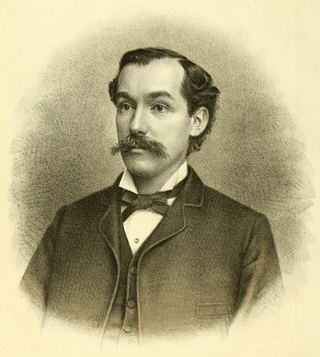
Thomas George Gentry was an American educator, ornithologist, naturalist and animal rights writer. Gentry authored an early work applying the term intelligence to plants.

The Massacre at Matanzas Inlet was the mass killing of French Huguenots by Spanish Royal Army troops near the Matanzas Inlet in 1565, under orders from King Philip II to Pedro Menéndez de Avilés, the adelantado of Spanish Florida.
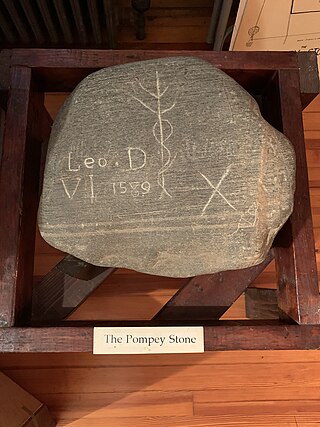
The Pompey stone was a stone that was carved as a hoax near Pompey, New York, circa 1820. Upon its discovery that year, the stone was quickly accepted as authentic, dated to circa 1520, and extensively analyzed by historians of the day for its significance as an early record of European presence in the region. It was commonly thought to have marked the grave of a Spaniard, who was proposed to have been an explorer, missionary, or captive of a Native American tribe.

José Ambrosio Brunetti y Gayeso, 15th Duke of Arcos GE was a Spanish aristocrat and diplomat who served as Minister Plenipotentiary in Bolivia, Uruguay, Chile, Mexico, the United States and Belgium, and ambassador to Italy and Russia. He was also an important benefactor of the Prado Museum, to which he made a posthumous bequest of ten paintings, including Young Man with a Feather Hat, by Pieter Hermansz Verelst.
References
- 1 2 3 American Anthropologist. American Anthropological Association. 1906. p. 437.
- 1 2 "DUKE'S GIFT TO HARVARD.; Spanish Grandee with American Wife Donates a Fund of $20,000". The New York Times . 2 October 1910. Retrieved 10 May 2024.
- 1 2 3 Beyer, Robert Carlyle (1961). "Review of The Spanish Settlements within the Present Limits of the United States 1513-1574". The Florida Historical Quarterly. 39 (3): 279–281. ISSN 0015-4113. JSTOR 30139862.
- 1 2 3 Haddick, Jack A. (1959). "Review of The Spanish Settlements within the Present Limits of the United States" . The Journal of Southern History. 25 (4): 524–526. doi:10.2307/2954455. ISSN 0022-4642. JSTOR 2954455.
- 1 2 "The Spanish Settlements within the Present Limits of the United States. Florida 1652-1574". The Southern History Association: 427–428. 1905.
- 1 2 "Book Notices". Missouri Historical Review: 156–157. 1912.
- ↑ "The Spanish Settlements within the Present Limits of the United States. 1513–1561. By Woodbury Lowery. (New York: G. P. Putnam's Sons. 1901. Pp. 515.)". The American Historical Review. October 1901. doi:10.1086/ahr/7.1.158. ISSN 1937-5239.
- ↑ Harvard Alumni Bulletin. Harvard Bulletin, Incorporated. 1910. p. 21. Retrieved 10 May 2024.
- ↑ TIMES, Special to THE NEW YORK (13 March 1934). "ARCOS ART IS LEFT TO NATIONAL GALLERY; Duchess, the Former Virginia Lowery, Bequeathed Collection of Pictures and Fans". The New York Times . Retrieved 10 May 2024.